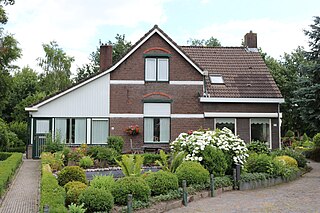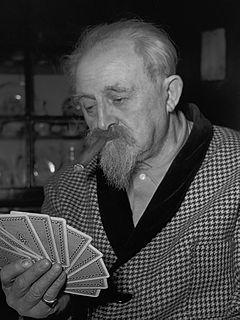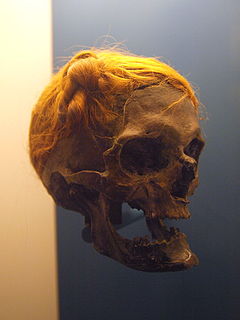
Drenthe is a province of the Netherlands located in the northeastern part of the country. It is bordered by Overijssel to the south, Friesland to the west, Groningen to the north, and the German state of Lower Saxony to the east. As of November 2019, Drenthe had a population of 493,449 and a total area of 2,680 km2 (1,030 sq mi).

A bog body is a human cadaver that has been naturally mummified in a peat bog. Such bodies, sometimes known as bog people, are both geographically and chronologically widespread, having been dated to between 8000 BCE and the Second World War. The unifying factor of the bog bodies is that they have been found in peat and are partially preserved; however, the actual levels of preservation vary widely from perfectly preserved to mere skeletons.

Meppel is a city and municipality in the Northeastern Netherlands. It constitutes the southwestern part of the province of Drenthe. Meppel is the smallest municipality in Drenthe, with a total area of about 57 km². As of 1 July 2021, it had a population of 34,506 with over 30,000 inhabitants within city limits.

Tjerk Vermaning was a Dutch amateur archaeologist who is now mostly remembered for the court case and media frenzy that followed the assessment of professional archaeologists that he had forged certain of his prehistoric archaeological 'finds'.

Yde Girl is a bog body found in the Stijfveen peat bog near the village of Yde, Netherlands. She was found on 12 May 1897 and was reputedly uncannily well-preserved when discovered, but by the time the body was turned over to the authorities two weeks later, it had been severely damaged and deteriorated. Most of her teeth and hair had been pulled from the skull. The peat cutting tools had also been reported to have severely damaged the body.

Smilde is a town in the Netherlands' northern province of Drenthe and lies about 10 kilometers (6.2 mi) southwest of the province capital of Assen. Smilde was a separate municipality until 1998, when it became a part of Middenveld. Hoever, that name changed in 2000 and was renamed the municipality of Midden-Drenthe.

Anloo is a village in the Dutch province of Drenthe. It is a part of the municipality of Aa en Hunze, and lies about 10 km east of Assen.

Gasselte is a village in the Dutch province of Drenthe. Located in the municipality of Aa en Hunze, it is situated about 16 km east of Assen. In 2021, it had a population of 1,770.

Nieuw-Amsterdam is a village in the northeast Netherlands, in the Dutch province of Drenthe. It borders the village of Veenoord, the twin village of Nieuw-Amsterdam. Since 1998 Nieuw-Amsterdam and Veenoord are part of the municipality of Emmen.

The Weerdinge Men is the name given to two bog bodies found in 1904 in Weerdinge, Drenthe, in the southern part of Bourtange moor, in the Netherlands. Radiocarbon dating shows that they likely died between 160 BC and 220 AD. At first, it was believed that one of the two bodies was female, which led to the name "Weerdinge Couple", or, more popular, "Mr. and Mrs. Veenstra", veen being the Dutch term for bog and "Veenstra" being a common Dutch surname.

Noord-Sleen is a village in the Netherlands and is part of the Coevorden municipality in Drenthe.

Weerdinge is a neighbourhood and former village of Emmen in the Dutch province of Drenthe.

Loon is a village in the Netherlands and is part of the Assen municipality in Drenthe. The hunebed (dolmen) D15 is located near the village.

Johannes Carolus Bernardus (Jan) Sluijters, or Sluyters was a Dutch painter and co-founder of the Moderne Kunstkring.

Osterby Man or the Osterby Head is a bog body of which only the skull and hair survived. It was discovered in 1948 by peat cutters to the southeast of Osterby, Germany. The hair is tied in a Suebian knot. The head is at the State Archaeological Museum at Gottorf Castle in Schleswig, Schleswig-Holstein.

The Drents Museum is an art and history museum in Assen, Drenthe, in the Netherlands. The museum was opened in 1854. It has a collection of prehistorical artifacts, applied art, and visual art. The museum also has temporary exhibitions. In 2013, it had 227,000 visitors.
Alfred Dieck was a German archaeologist internationally recognised for the scientific studies on bog bodies and bog finds. Since the early 1990s, the results of his scientific work have been critically reviewed and found to be wrong in major parts.

Pesse is a village in the Dutch province of Drenthe. It is located in the municipality of Hoogeveen.

Annie Nicolette Zadoks Josephus Jitta was a Dutch numismatist and archaeologist.


















